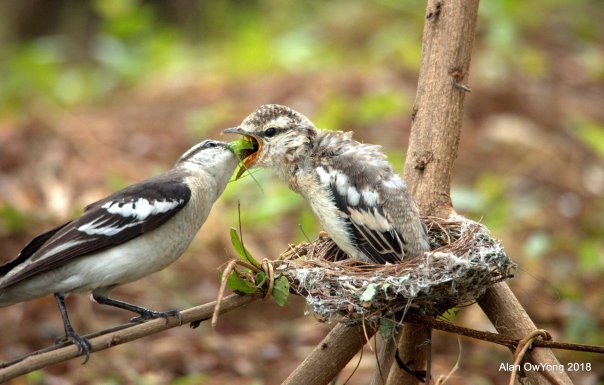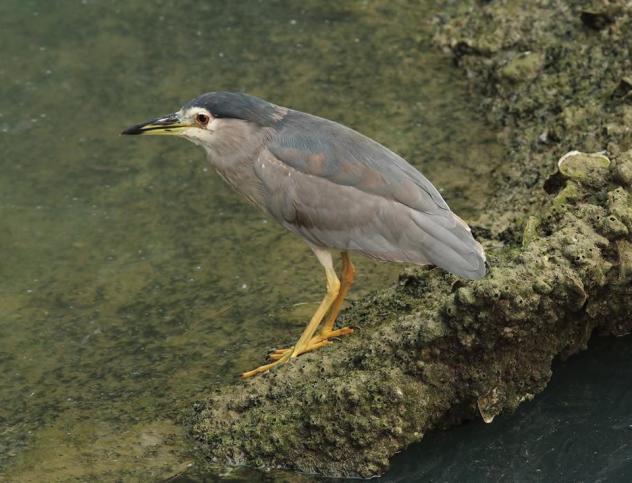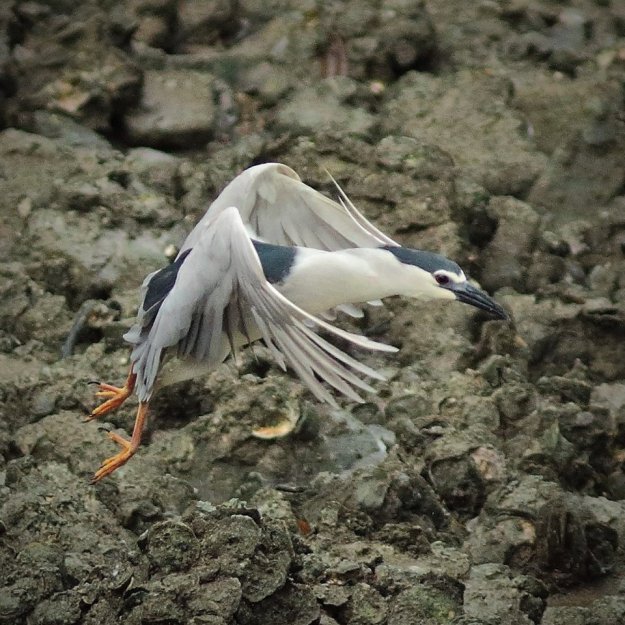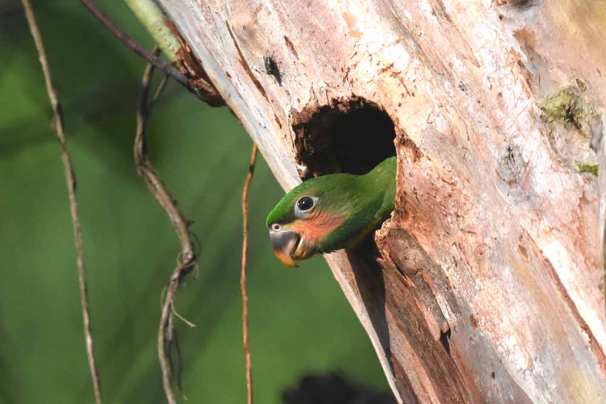Breeding activities continue to be reported in July, while the first migrants from the northern hemisphere began to arrive at our shores. In the meantime, reports of three charismatic species of birds – the Blue-eared Kingfisher, the Blyth’s Paradise Flycatcher and the Blue-winged Pitta feature in this month’s report.

A Blue-eared Kingfisher photographed by Amin at Singapore Botanic Gardens on 31 July 2018.
Birdwatchers and photographers are familiar with the Blue-eared Kingfisher Alcedo meninting which is quite regularly seen at Kranji Marsh (KM); one was spotted on 2 July 2018 by Amin. It was therefore a pleasant surprise to note reports of this rather skittish species at Venus Loop on 13 July 2018 by Terence Tan, the Lower Pierce Reservoir on 15 July 2018 (1 adult & 1 juvenile) by Adrian Silas Tay, and Singapore Botanic Gardens on 30 July 2018 & 31 July 2018 by Peter Hosner and Amin respectively. This kingfisher is known to live in mangroves, understoreys of forests, peat swamps, and forest streams. They may move out from forest edges into abutting streams, and only rarely visits rivers open enough to attract Common Kingfishers (Wells, 1999:523). It is therefore encouraging to know that the dimunitive kingfisher is increasingly encountered outside the Kranji Marsh and Central Catchment Nature Reserve.

A Blue-winged Pitta photographed by visiting biologist from Canberra, Shoshana Rapley, at Pulau Ubin on 4 July 2018.
The charismatic Blue-winged Pitta Pitta moluccensis is more often encountered during the later part of the year. Two birds were reported – one on 4 July 2018 near Chek Jawa on Pulau Ubin by visiting Australian biologist, Shoshana Rapley, and another on 8 July 2018 at Ama Keng, which is situated in the western end of Singapore by Martin Kennewell. Lambert & Woodcock (1996:166-167) suggested that this Pitta breeds from southern Yunnan, Vietnam, Laos, Cambodia through Thailand, to northern Peninsular Malaysia, and migrate southwards during the northern winter. The pitta’s breeding range has extended southwards since, reaching Taman Negara Kuala Tahan in 2005 and finally, Singapore in 2016.

A Blyth’s Paradise Flycatcher at Singapore Botanic Gardens on 14 July 2018 photographed by Keita Sin.
The Blyth’s Paradise Flycatcher Terpsiphone affinis was spotted at Windsor Park on 5 July 2018 by Amin, and verified by Luke Milo Teo. Another was seen at the Singapore Botanic Garden’s Rainforest Broadwalk on 14 July 2018 by Keita Sin. This species of Paradise Flycatcher is one of the early migrants, with its close cousin the Amur Paradise Flycatcher probably coming through later.
Central Catchment Nature Reserve (CCNR)
A number of residents were reported to be breeding in the CCNR and its environs. A juvenile Drongo Cuckoo Surniculus lugubris was seen from Jelutong Tower on 1 July 2018 by Francis Yap, while a nesting Straw-headed Bulbul Pycnonotus zeylanicus was spotted at Dairy Farm Nature Park (DFNP) on 11 July 2018 by Alan Owyong, and a juvenile Chestnut-bellied Malkoha Phaenicophaeus sumatranus was seen within Bukit Timah Nature Reserve (BTNR) on 13 July 2018 by John Marriott. Also spotted within the CCNR were twelve Blue-rumped Parrots Psittinus cyanurus, two of which were juveniles, at Old Upper Thomson Road on 22 July 2018 by Adrian Silas Tay.

A juvenile Drongo Cuckoo photographed from Jelutong Tower on 1 July 2018 by Francis Yap.
Resident species observed include a Black-headed Bulbul Pycnonotus atriceps at BTNR on 1 July 2018 by Natelia Cyluk, Chestnut-winged Babbler Stachyris erythroptera within CCNR on 6 July 2018 by Alan Owyong, a calling Red-legged Crake Rallina fasciata along Upper Thomson Road on 15 July 2018 by Swen Einhaus, Red-crowned Barbet Megalaima rafflesii at DFNP on 29 July 2018 by Martin Kennewell, and a Violet Cuckoo Chrysococcyx xanthorhynchus on 31 July 2018 at Singapore Quarry by Lim Kim Chuah.

A juvenile and adult Blue-rumped Parrot photographed by Adrian Silas Tay on 1 July 2018 inside the CCNR.
Singapore Botanic Gardens (SBG)
Apart from the Blue-eared Kingfisher and Blyth’s Paradise Flycatcher mentioned earlier, SBG yielded Asian Palm Swift Cypsiurus balasiensis, spotted on 24 July 2018 by Doug Armstrong, and an early Common Kingfisher Alcedo atthis on 25 July 2018 by Shirley Ng at the Symphony Lake. The previous earliest arrival date for this kingfisher was 9 August.
Northern Singapore
On 14 July 2018, Jimmy Lee observed a juvenile Banded Bay Cuckoo Cacomantis sonneratii being fed by a Common Iora Aegithina tiphia at Lorong Halus. Other residents spotted include an Oriental Honey Buzzard Pernis ptilorhynchus torquatus tweeddale morph at Springleaf Park on 10 July 2018 by Veronica Foo, a Malaysian Plover Charadrius peronii on 29 July 2018 by Zacc, and a Great-billed Heron Ardea sumatrana on 30 July 2018 by Martin Kennewell, both at Seletar Dam.
Migratory species were also reported. Adrian Silas Tay reported a Chestnut-winged Cuckoo Clamator coromandus on the tiled floor of some Sembawang HDB flats on 17 July 2018, which is more than a month earlier than the known arrival dates – could this individual be a true migrant or a released bird? Lesser Sand Plover Charadrius mongolus were seen on two days: 7 birds, some still in summer plumage, on 27 July 2018 and 31 birds on 29 July 2018, at Seletar Dam by Zacc. Two Common Sandpipers Actitis hypoleucos were reported by David Li on 23 July 2018 at SBWR. All three represented the first arrivals for the season.

Lesser Sand Plover at Seletar Dam photographed by Zacc HD on 27 July 2018.
Eastern Singapore
A Plaintive Cuckoo Cacomantis merulinus was spotted at Pasir Ris Park (PRP) on 3 July 2018 by Marc Ng, while a Mangrove Pitta Pitta megarhyncha was seen on Pulau Ubin on 4 July 2018 by William Mahoney. A Peregrine Falcon Falco peregrinus spotted at Changi Coastal Road on 25 July 2018 by Mike Smth was suspected to be of the resident ernesti race.
Migratory species included a Grey Wagtail Motacilla cinerea, which was spotted at Changi Business Park on 1 and 3 July 2018 by T. Ramesh, who also saw an Intermediate Egret Egretta intermedia on 8 July 2018 at Pasir Ris Farmway 3. Two Oriental Honey Buzzards were seen: one juvenile at East Coast Park on 15 July 2018 by Zhang Licong, and a sub-adult male was spotted at Tampines Eco Green on 22 July 2018 by Pary Sivaraman. Two Common Sandpiper Actitis hypoleucos were spotted by Lim Kim Seng on 30 July 2018 on Pulau Ubin, and constitute the first record for the season.

Oriental Honey Buzzard at Tampines Eco-Green photographed by Pary Sivaraman on 22 July 2018.
Southern Singapore
Alan Owyong spotted a Pied Triller Lalage nigra nest with two chicks on 29 July 2018 at One-north Crescent; one of the chicks was killed by an Asian Koel Eudynamys scolopaceus that raided the nest, but the other chick survived. On 15 July 2018, at Gardens by the Bay, an active Malaysian Pied Fantail Rhipidura javanica nest with young chicks was discovered by Elena, and a Scaly-breasted Munia Lonchura punctulata was building a nest (Khoo Meilin). A pair of Straw-headed Bulbul was spotted at Telok Blangah Hill on 19 July 2018 by Alan Owyong. Four Black-naped Tern Sterna sumatrana were seen at Marina Barrage on 27 July 2018 by William Mahoney, while a juvenile Drongo Cuckoo was found dead on the pavement next to Citilink Warehouse on 30 July 2018 by See Toh Yew Wai.

One of two Straw-headed Bulbul photographed by Alan Owyong at Telok Blangah Hill on 19 July 2018.
In terms of migratory species in the south, John Marriott saw a Pond Heron Ardeola sp. still in its indeterminate non-breeding/juvenile type plumage on Sentosa on 6 July 2018.
Two possible escapees were reported – a White-rumped Munia Lonchura striata was seen in a mixed flock of Javan and other munia at Telok Blangah Heights on 9 July 2018 by Dean Tan, while a Ruby-throated Bulbul Pycnonotus dispar was seen on 16 July 2018 at Kent Ridge Park by Alan Owyong.

Western Singapore
A juvenile Little Bronze Cuckoo Chrysococcyx minutillus was being fed by a Common Iora Aegithina tiphia on 27 July 2018 at Jurong Central Park, reported Lee Kia Chong, while a Lesser Adjutant Leptoptilos javanicus was seen on 8 July 2018 at Sungei Buloh Wetland Reserve (SBWR) by Margaret Oorebeek.
Martin Kennewell spotted two firsts of the season – a Barn Swallow Hirundo rustica on 28 July 2018 at KM, and about four to five Little Ringed Plover Charadrius dubius on the same day at Kranji Golf Course; the birds were still in their summer plumage.

Little Ringed Plover at Kranji Golf Course photographed by Martin Kennewell on 28 July 2018.
Abbreviations:
BTNR: Bukit Timah Nature Reserve
CCNR: Central Catchment Nature Reserve
DFNP: Dairy Farm Nature Park
JEG: Jurong Eco-Garden
SBG: Singapore Botanic Gardens
SBWR: Sungei Buloh Wetland Reserve
TEG: Tampines Eco-Green
This report is compiled by Geoff Lim and Alan OwYong, edited by Tan Gim Cheong based on selected postings in various facebook birding pages, bird forums, individual reports and extracts from ebird. This compilation is not a complete list of birds recorded for the month and not all the records were verified. We wish to thank all the contributors for their records. Many thanks to Amin, Shoshana Rapley, Keita Sin, Francis Yap, Adrian Silas Tay, Zacc HD, Alan Owyong, and Martin Kennewell for the use of their photos.
References:
Lambert, F. & Woodcock, M. (1996) Pittas, Broadbills & Asites. London: Pica Press.
Wells, D. R. (1999). The Birds of Thai-Malay Peninsula. Vol. 1. Non-passerines. London: Academic Press.
List of Bird Sightings in report:
| Family |
Species |
Date |
| Ciconidae |
Lesser Adjutant |
8-Jul |
| Ardeidae |
Pond Heron |
6-Jul |
| Great-billed Heron |
30-Jul |
| Intermediate Egret |
8-Jul |
| Accipitridae |
Oriental Honey Buzzard |
10-Jul |
| Oriental Honey Buzzard |
15-Jul |
| Oriental Honey Buzzard |
22-Jul |
| Rallidae |
Red-legged Crake |
15-Jul |
| Charadriidae |
Little Ringed Plover |
28-Jul |
| Malaysian Plover |
29-Jul |
| Lesser Sand Plover |
27-Jul |
| Lesser Sand Plover |
29-Jul |
| Scolopacidae |
Common Sandpiper |
30-Jul |
| Laridae |
Black-naped Tern |
27-Jul |
| Cuculidae |
Chestnut-bellied Malkoha |
13-Jul |
| Chestnut-winged Cuckoo |
17-Jul |
| Violet Cuckoo |
31-Jul |
| Little Bronze Cuckoo |
27-Jul |
| Banded Bay Cuckoo |
14-Jul |
| Plaintive Cuckoo |
3-Jul |
| Drongo Cuckoo |
1-Jul |
| Drongo Cuckoo |
30-Jul |
| Apodidae |
Asian Palm Swift |
24-Jul |
| Alcedinidae |
Blue-eared Kingfisher |
2-Jul |
| Blue-eared Kingfisher |
13-Jul |
| Blue-eared Kingfisher |
15-Jul |
| Blue-eared Kingfisher |
30-Jul |
| Blue-eared Kingfisher |
31-Jul |
| Common Kingfisher |
25-Jul |
| Megalaimidae |
Red-crowned Barbet |
29-Jul |
| Falconidae |
Peregrine Falcon |
25-Jul |
| Peregrine Falcon |
28-Jul |
| Psittacidae |
Blue-rumped Parrot |
22-Jul |
| Pittidae |
Blue-winged Pitta |
4-Jul |
| Blue-winged Pitta |
8-Jul |
| Mangrove Pitta |
4-Jul |
| Monarchidae |
Blyth’s Paradise Flycatcher |
5-Jul |
|
Blyth’s Paradise Flycatcher |
14-Jul |
| Hirundinidae |
Barn Swallow |
28-Jul |
| Pycnonotidae |
Straw-headed Bulbul |
19-Jul |
| Straw-headed Bulbul |
11-Jul |
| Black-headed Bulbul |
1-Jul |
| Ruby-throated Bulbul |
16-Jul |
| Timaliidae |
Chestnut-winged Babbler |
6-Jul |
| Estrididae |
White-rumped Munia |
9-Jul |
| Motacillidae |
Grey Wagtail |
1-Jul |




















































